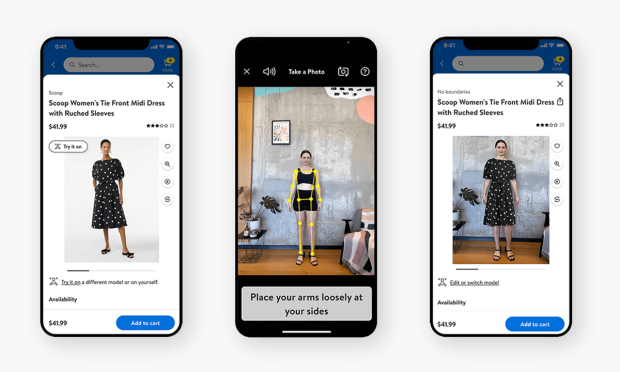Walmart Upgrades Virtual Try-on Experience as Retail Fitting Tech Scales

For the second time in a year, Walmart has upgraded its virtual try-on technology via its new “Be Your Own Model” feature that literally puts shoppers in the picture.
In announcing the latest upgrade, Walmart said its industry-leading technology would bring the in-store fitting room experience to online shoppers.
“This experience allows customers to use their own photo to better visualize how clothing will look on them and creates a gamification of shopping that we believe will be very compelling to the customer,” Walmart U.S. Executive Vice President, Apparel and Private Brands Denise Incandela said in a blog post.
A video embedded in the press release shows how the new feature works via the Walmart app and a smartphone camera to upload real images and body measurements like height, enabling shoppers to try on a large assortment of apparel and accessories on lifelike selfies.
Armed with their own image, “we’re able to deliver it at Walmart’s incredible scale. The feature is now available on more than 270,000 items across Walmart’s portfolio of exclusive, elevated brands and private brands,” the company said.
By using images of actual shoppers captured in-app, Walmart wants to move the needle and realize revenues from investments made in AR tech, namely its 2021 acquisition of the Zeekit dynamic virtual fitting room platform.
Walmart piloted a version of Choose My Model in the first quarter of 2022, but in that rollout, shoppers had to choose from 50 preloaded model images and find one that looked like them. In this announcement, Walmart said, “With Be Your Own Model, a customer sees an ultra-realistic simulation with shadows, fabric draping and where clothing falls on their figure in seconds. For example, a single shirt can come in six different colors, seven different sizes and two sleeve lengths. Our technology captures all the variations and shows how they look uniquely on each individual.”
Virtual fitting has been tested and tried for at least five years in various forms, and some brands have had more success — think of Warby Parker and its virtual eyeglass fitting tech — but consumers haven’t exactly flocked to the concept. But the desire is there.
PYMNTS research has found healthy consumer interest in VR shopping, with the “How We Will Pay” study done in collaboration with Visa finding that during the pandemic interest began spiking, with over 30% of consumers surveyed saying they were either very interested (15.6%), or extremely interested (14.2%) in virtual simulation of clothing fit, and 1.6% of respondents saying they were already using this technology in their shopping routines.
Read also: Magic Mirror on the Wall, Will Virtual Fitting Rooms Happen After All?
Try-on Tech Finding Its Niche
With connected devices now ubiquitous and with artificial intelligence (AI) learnings from the pandemic-era ecommerce boom providing rich user session data, VR apparel try-on is seizing an opportunity to move more to the mainstream as winter gifting season closes in.
Earlier this year, Amazon showed a take on “virtual” fashion with its opening of the Amazon Style location at The Americana at Brand mall in Los Angeles. While not a virtual try-on experience, it’s a thoroughly connected retail experience, with consumers navigating boutique by mobile app, scanning QR codes, and sending items directly to preassigned fitting rooms.
Of that pilot, Amazon said in a blog post that “Our machine learning algorithms produce tailored, real-time recommendations for each customer as they shop. As customers browse the store and scan items that catch their eye, we’ll recommend picks just for them.”
It added that “for an even more tailored experience, customers can share information like their style, fit, and other preferences to receive more refined recommendations. Even shopping for deals is personalized and convenient — customers can easily view deals in store that match their preferences right in the Amazon Shopping app.”
Reducing returns is a key reason that retailers and brands continue developing virtual try-on. Early this year, VF Corp., which owns brands including Dickie’s apparel and Vans sneakers reported that its virtual try-on tech was seeing strong demand.
Working with virtual try-on technology firm 3DLook on virtual try-on for Chinese consumers using Alibaba’s Tmall platform, PYMNTS wrote in Q1 2022, “Dickies reported that 87% of customers said 3DLook’s digital fitting tool had improved the shopping experience and that they would like to see the size and fit recommendations software added to more products.”
Whitney Cathcart, co-founder and chief strategy officer at 3DLOOK, told PYMNTS there are several things VF is doing with the technology, including finding new ways to cut back on returns, and to track them better, while developing new insights as the AI in the system grows while absorbing data and shopping trends unique to each retailers’ customers.
See: VF’s Dickies Brand Boosts Conversions, Slashes Returns With Virtual Fitting
For all PYMNTS retail coverage, subscribe to the daily Retail Newsletter.
